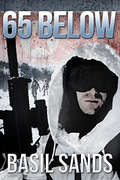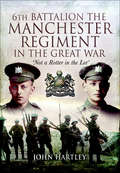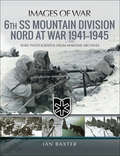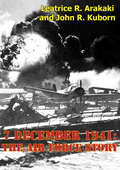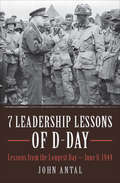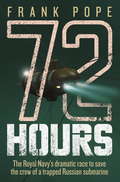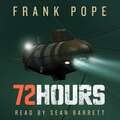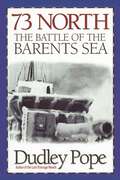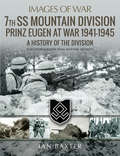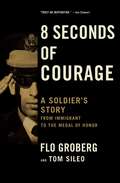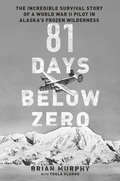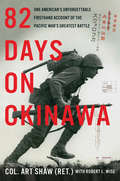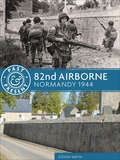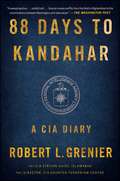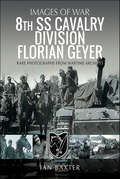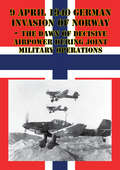- Table View
- List View
65 Below
by Basil SandsA red-hot apocalyptic thriller from a writer “penning stories pumped with enough adrenaline that you’ll suffer from insomnia until you read the last word” (Jeremy Robinson, New York Times–bestselling author).A nearly forgotten bunker in the frozen wastes of Alaska is hiding a weapon that could end the world. And only Marcus Johnson and his team can keep it from falling into the worst possible hands.Retired Marine Master Sergeant Marcus “Mojo” Johnson—back on his family homestead in rural Alaska after twenty years of chasing bad men—enlists an elite team of combat veterans and personal friends to intercept the enemy before it releases a decades-old secret that can’t be destroy and was never meant to be found. And it all plays out in the brutal, beautiful Alaskan wilderness, in sub-zero temperatures where human flesh freezes in mere minutes.The chase is on, and only Mojo and his allies can stop the apocalypse before it begins.Praise for Basil Sands and his thrillers“Basil Sands’s Ice Hammer is a gripping, can’t-put-it-down series that works at every level. It’s got it all: love, war, treachery, and heroism. A home run!” —John Gilstrap, New York Times–bestselling author“Sands is fearless in his storytelling, and tireless in his quest to connect directly with his audience.” —Scott Sigler, #1 New York Times–bestselling author“Basil Sands has a knack for blending action and intrigue in an all-too realistic setting. In Karl’s Last Flight, the future is reminiscent of our recent past. I just hope there are heroes like Basil’s heroes fighting on our side.” —Evo Terra, founder of Podiobooks.com
6th Battalion, The Manchester Regiment in the Great War
by John HartleyThe 6th Battalion, The Manchester Regiment, was a prewar Territorial unit. Many of its members held white collar positions employed by the Citys legal, financial and stockbroking practices or worked for the major commercial organizations trading and manufacturing cotton goods. It went overseas in September 1914, taking with it many new recruits who would undertake their basic training whilst the Battalion formed part of the British garrison in Egypt.It saw action at Gallipoli from May 1915 until the evacuation at the end of the year and fascinating campaign is dealt with in considerable detail. The Battalion returned to Egypt until the spring of 1917 when it moved to France.The Manchesters saw regular action for most of 1918, coming under attack in the German offensive in March. Throughout the summer and autumn, the Battalion took part in the Advance to Victory and was still advancing when the Armistice was signed in November.The book also recounts the history of the second line battalion, the 2/6th Manchesters, from its inception in 1914 until it was all but destroyed in March 1918.The author draws on official records and personal accounts to tell the story of these fine battalions.
6th Battalion, the Cheshire Regiment in the Great War: A Territorial Battalion on the Western Front 1914–1918
by John HartleyThe 6th Battalion, the Cheshire Regiment, was a prewar Territorial battalion that recruited in the North Cheshire towns of Stockport, Hyde and Stalybridge, together with the Derbyshire town of Glossop. The majority of its part-time soldiers worked in the areas cotton mills and hat making factories. One of the first Territorial battalions to see action in the Great War, it went overseas in November 1914, taking part in the famous Christmas truce a few weeks later.In 1916, it saw major action during the Battle of the Somme. The following year, it suffered heavy casualties during the action around the Belgian town of Ypres, which is often known as the Battle of Passchendaele. In 1918 the Battalion fought to hold off German advances in the spring but, along with the rest of the BEF, was forced to retreat many miles. By the summer of that year the tide had turned and the Cheshire's took part in the final advances that ended the war in November.The story is told from the Battalions formation in 1908 to its disbandment in the 1920s and beyond with details of the Old Comrades Association. Official accounts are supplemented by the mens own words, taken from diaries, letters and newspaper reports.
6th SS Mountain Division Nord at War, 1941–1945: Rare Photographs from Wartime Archives (Images of War)
by Ian BaxterDrawing on a superb collection of rare and unpublished photographs the 6th SS Mountain Division Nord 1941 - 1945 is the 6th book in the Waffen-SS Images of War Series compiled by Ian Baxter. The book tells the story of the 6th SS Mountain Division Nord, which was formed in February 1941 as SS Kampfgruppe Nord (SS Battle Group North). The Division was the only Waffen-SS unit to fight in the Arctic Circle when it was stationed in Finland and northern Russia between June and November 1941. It fought in Karelia until the Moscow Armistice in September 1944, at which point it left Finland. It suffered heavy losses in the Operation Nordwind in January 1945 and in early April 1945, the division was destroyed by the US forces near Budingen, Germany.
7 December 1941: The Air Force Story [Illustrated Edition]
by Leatrice R. Arakaki John R. KubornIncludes 3 charts, 7 tables and 137 photosDecember 7, 1941, was by any assessment a devastating day. The Hawaiian Air Force suffered a crippling blow, but the genesis of recovery and final victory over the enemy emerged in the valor of those who weathered the onslaught and fought back with everything they had.In the 50 years since then, the attack has become a faded memory for some and to many members of the younger generation just another moment in history. It deserves better understanding and commemoration, however, for this sudden, damaging strike on our forces marked the beginning of America's involvement in a terrible global war that was massive in scope and destruction.At Hickam Air Force Base, reminders of the attack are still visible. The tattered flag that flew over the base that fateful morning is encased and on display in the lobby of the Pacific Air Forces Headquarters building, where bullet-scarred walls serve as a constant reminder to never again be caught unprepared. Memorial tablets surrounding the base flagpole pay tribute to those who sacrificed their lives for our country.Our predecessors, with their blood and sweat, boldly wrote a major chapter of our military history. We must never forget their story and the legacy of their experience--that the price of freedom is eternal vigilance and readiness.
7 Leadership Lessons of D-Day: Lessons from the Longest Day—June 6, 1944
by John Antal<p>“Drawing universal truths from urgent battlefield crises, the author provides a terrific guide and training tool for leaders at all levels” (Ralph Peters, New York Times–bestselling author).<p> <p>The odds were against the Allies on June 6, 1944. The task ahead of the paratroopers who jumped over Normandy and the soldiers who waded ashore onto the beaches, all under fire, was colossal. In such circumstances, good leadership can be the deciding factor of victory or defeat. This book is about the extraordinary leadership of seven men who led American soldiers on D-Day and the days that followed. Some of them, like Eisenhower, Theodore Roosevelt Jr., and Lt. Dick Winters, are well known, while others are barely a footnote in the history books.<p> <p>This book is not a full history of D-Day, nor does it cover the heroic leadership shown by men in the armies of the Allies or members of the French Resistance, who also participated in the Normandy assault and battles for the lodgment areas. It is, however, a primer on how you can lead today, no matter what your occupation or role in life, by learning from the leadership of these seven figures.<p> <p>A critical task for every leader is to understand what leadership is. Socrates once said that you cannot understand something unless you can first define it in your own words. This book provides the reader with the means to define leadership by telling seven dramatic, immersive, and memorable stories that the reader will never forget.<p>
72 Hours
by Frank PopeThe Royal Navy's dramatic race to save the crew of a trapped Russian submarine.5 August 2005. On a secret mission to an underwater military installation 30 miles off the coast of Kamchatka, Russian Navy submersible AS-28 ran into a web of cables and stuck fast. With 600 feet of freezing water above them, there was no escape for the seven crew. Trapped in a titanium tomb, all they could do was wait as their air supply slowly dwindled.For more than 24 hours the Russian Navy tried to reach them. Finally - still haunted by the loss of the nuclear submarine Kursk five years before - they requested international assistance. On the other side of the world Commander Ian Riches, leader of the Royal Navy's Submarine Rescue Service, got the call: there was a sub down.With the expertise and specialist equipment available to him Riches knew his team had a chance to save the men, but Kamchatka was at the very limit of their range and time was running out. As the Royal Navy prepared to deploy to Russia's Pacific coast aboard a giant Royal Air Force C-17 airlifter, rescue teams from the United States and Japan also scrambled to reach the area.On board AS-28 the Russian crew shut down all non-essential systems, climbed into thick thermal suits to keep the bone-chilling damp at bay and waited, desperate to eke out the stale, thin air inside the pressure hull of their craft. But as the first of them began to drift in and out of consciousness, they knew the end was close. They started writing their farewells.72 HOURS tells the extraordinary, edge-of-the-seat and real-life story of one of the most dramatic rescue missions of recent years.
72 Hours
by Frank PopeThe Royal Navy's dramatic race to save the crew of a trapped Russian submarine.5 August 2005. On a secret mission to an underwater military installation 30 miles off the coast of Kamchatka, Russian Navy submersible AS-28 ran into a web of cables and stuck fast. With 600 feet of freezing water above them, there was no escape for the seven crew. Trapped in a titanium tomb, all they could do was wait as their air supply slowly dwindled.For more than 24 hours the Russian Navy tried to reach them. Finally - still haunted by the loss of the nuclear submarine Kursk five years before - they requested international assistance. On the other side of the world Commander Ian Riches, leader of the Royal Navy's Submarine Rescue Service, got the call: there was a sub down.With the expertise and specialist equipment available to him Riches knew his team had a chance to save the men, but Kamchatka was at the very limit of their range and time was running out. As the Royal Navy prepared to deploy to Russia's Pacific coast aboard a giant Royal Air Force C-17 airlifter, rescue teams from the United States and Japan also scrambled to reach the area.On board AS-28 the Russian crew shut down all non-essential systems, climbed into thick thermal suits to keep the bone-chilling damp at bay and waited, desperate to eke out the stale, thin air inside the pressure hull of their craft. But as the first of them began to drift in and out of consciousness, they knew the end was close. They started writing their farewells.72 HOURS tells the extraordinary, edge-of-the-seat and real-life story of one of the most dramatic rescue missions of recent years.
72 Hours
by Frank Pope5 August 2005. On a secret mission to an underwater military installation 30 miles off the coast of Kamchatka, Russian Navy submersible AS-28 ran into a web of cables and stuck fast. With 600 feet of freezing water above them, there was no escape for the seven crew. Trapped in a titanium tomb, all they could do was wait as their air supply slowly dwindled.For more than 24 hours the Russian Navy tried to reach them. Finally - still haunted by the loss of the nuclear submarine Kursk five years before - they requested international assistance. On the other side of the world Commander Ian Riches, leader of the Royal Navy's Submarine Rescue Service, got the call: there was a sub down.With the expertise and specialist equipment available to him Riches knew his team had a chance to save the men, but Kamchatka was at the very limit of their range and time was running out.As the Royal Navy prepared to deploy to Russia's Pacific coast aboard a giant Royal Air Force C-17 airlifter, rescue teams from the United States and Japan also scrambled to reach the area.On board AS-28 the Russian crew shut down all non-essential systems, climbed into thick thermal suits to keep the bone-chilling damp at bay and waited, desperate to eke out the stale, thin air inside the pressure hull of their craft. But as the first of them began to drift in and out of consciousness, they knew the end was close. They started writing their farewells.72 HOURS tells the extraordinary, edge-of-the-seat and real-life story of one of the most dramatic rescue missions of recent years.Read by Sean Barrett(p) 2012 Isis Publishing Ltd
73 North: The Battle of the Barents Sea
by Dudley PopeThe events and decisions that culminated in the Battle of the Barents Sea—what many consider to be the most important naval engagement of World War II's European theatre—in which eight of the German navy's most powerful ships failed to sink a Russian convoy guarded by only four small British destroyers, are brought to life by the author in this tale of men struggling to carry out their orders in the face of overwhelming obstacles.
7th SS Mountain Division Prinz Eugen At War, 1941–1945: A History of the Division (Images of War)
by Ian BaxterThis volume of rare WWII photographs presents a pictorial history of the Nazi mountain infantry division that fought in Croatia and the Balkans. Drawing on a superb collection of rare and unpublished photographs, this book tells the story of the 7th SS Mountain Division during the Second World War. Formed in 1941, it consisted of both volunteers and conscripts from the Banat, Independent State of Croatia, Hungary and Romania. The Prinz Eugen SS Division fought a brutal counterinsurgency campaign against the communist-led Yugoslav Partisan resistance forces in occupied Serbia and Montenegro. It was given the title Prinz Eugen after Prince Eugene of Savoy, a 17th century military leader of the Habsburg Empire. Covering the Divisions history from formation to the end of the war, this volume includes chapters on Operation Weiss, guerilla warfare, and other topics.
8 Seconds of Courage: A Soldier's Story from Immigrant to the Medal of Honor
by Tom Sileo Flo GrobergIn an inspiring story of valor and the making of a hero, Florent Groberg—who grew up in France and emigrated to the US—becomes the first immigrant in forty years to receive the Congressional Medal of Honor after he tackled a suicide bomber in Afghanistan.Florent &“Flo&” Groberg was born in the suburbs of Paris and moved to the US with his family in middle school. He became a naturalized citizen in 2001. After attending the University of Maryland, he joined the US Army and twice deployed to Afghanistan. In August of 2012, Flo was guarding a high-level US-Afghan delegation and noticed someone suspicious: a local man stumbling toward his patrol. Flo reacted quickly and ran to tackle the man—who was wearing a suicide vest. Four people died in the subsequent explosion, but many others were spared. Flo himself spent the next three years undergoing surgeries at Walter Reed Medical Center, and in 2015 he was given the nation&’s highest military award, the Congressional Medal of Honor—the first immigrant to be so recognized since the Vietnam War. What prepares a soldier for those critical moments in combat? 8 Seconds of Courage tells Flo&’s story from his childhood in France to his decision to enlist and the grueling training he underwent at US Army Ranger School. As a field commander on the front lines in Afghanistan he formed close and lasting bonds with his fellow soldiers. It was this powerful sense of responsibility that compelled him to take action to save lives, even at the risk of his own. &“Flo&’s incredible tale of bravery and service is also a stark reminder that for many of our warriors, coming home is not the end of the fight. Flo finds a way to live…Truly an inspiration&” (Jon Stewart). In his own words, Flo provides that essential insight into his selfless act while remembering his four fallen brothers in arms. 8 Seconds of Courage is a story of heroism, sacrifice, and camaraderie in wartime.
81 Days Below Zero: The Incredible Survival Story of a World War II Pilot in Alaska's Frozen Wilderness
by Brian MurphyShortly before Christmas in 1943, five Army aviators left Alaska’s Ladd Field on a test flight. Only one ever returned: Leon Crane, a city kid from Philadelphia with little more than a parachute on his back when he bailed from his B-24 Liberator before it crashed into the Arctic. Alone in subzero temperatures, Crane managed to stay alive in the dead of the Yukon winter for nearly twelve weeks and, amazingly, walked out of the ordeal intact. 81 Days Below Zero recounts, for the first time, the full story of Crane’s remarkable saga. In a drama of staggering resolve with moments of phenomenal luck, Crane learned to survive in the Yukon’s unforgiving landscape. His is a tale of the human capacity to endure extreme conditions and intense lonelinessand emerge stronger than before.
82 Days on Okinawa: One American's Unforgettable Firsthand Account of the Pacific War's Greatest Battle
by Robert L. Wise"A gritty, first-person account. ... One can hear Shaw’s voice as if he were sitting beside you." —Wall Street JournalAn unforgettable soldier’s-eye view of the Pacific War’s bloodiest battle, by the first American officer ashore Okinawa. On Easter Sunday, April 1, 1945, 1.5 million men gathered aboard 1,500 Allied ships off the coast of the Japanese island of Okinawa. The men were there to launch the largest amphibious assault on the Pacific Theater. War planners expected an 80 percent casualty rate.The first American officer ashore was then-Major Art Shaw (1920-2020), a unit commander in the U.S. Army’s 361st Field Artillery Battalion of the 96th Infantry Division, nicknamed the Deadeyes. For the next three months, Shaw and his men served near the front lines of the Pacific’s costliest battle, their artillery proving decisive against a phantom enemy who had entrenched itself in the rugged, craggy island. Over eighty-two days, the Allies fought the Japanese army in a campaign that would claim more than 150,000 human lives. When the final calculations were made, the Deadeyes were estimated to have killed 37,763 of the enemy. The 361st Field Artillery Battalion had played a crucial role in the victory. The campaign would be the last major battle of World War II and a key pivot point leading to the bombings of Hiroshima and Nagasaki, and to the Japanese surrender in August, two months after the siege’s end.Filled with extraordinary details, Shaw’s gripping account gives lasting testimony to the courage and bravery displayed by so many on the hills of Okinawa.
82nd Airborne: Normandy 1944 (Past & Present Series)
by Stephen Smith Simon Forty<p>An account of the heroic D-Day actions of the US Army’s first airborne division in the series that brings World War II battles to life.<p> <p>Since its formation on August 15, 1942, the 82nd Airborne, commanded by Major General Matthew B. Ridgway, trained exhaustively for their new role, which involved parachuting from C-47s and insertion by Waco CG-4A gliders. After participating in the invasion of Sicily and performing night parachute drops onto the Salerno beachhead in September 1943, the bulk of the division left for the United Kingdom and training for D-Day.<p> <p>Reorganized with two new parachute infantry regiments, the 507th and the 508th, joining the 505th, the division dropped onto the Cotentin peninsula between Ste-Mère-Église and Carentan on the night of June 5–6, in a mission codenamed Boston. Their glider-borne component, the 325th GIR, arrived the next day. Widely dispersed on landing, the division overcame its problems and strong German defenses to take the important town of Ste-Mère-Église. Further intense action along the Merderet River ensured that the Utah beachhead wasn’t compromised, and subsequently, the division fought on losing 5,245 troopers killed, wounded, or missing. When withdrawn after 33 days of action, the division could be satisfied it had performed heroically and helped establish the Allied forces’ foothold in France.<p> <p>The Past & Present Series reconstructs historical battles by using photography, juxtaposing modern views with those of the past together with concise explanatory text. It shows how much infrastructure has remained and how much such as outfits, uniforms, and ephemera has changed, providing a coherent link between now and then.<p>
88 Days to Kandahar
by Robert L. GrenierThe First American-Afghan War, a CIA war, was approved by President George W. Bush and directed by the author, Robert Grenier, the CIA station chief in Islamabad. Forging separate alliances with warlords, Taliban dissidents, and Pakistani intelligence, Grenier launched the "southern campaign," orchestrating the final defeat of the Taliban and Hamid Karzai's rise to power in eighty-eight chaotic days.In his gripping narrative, we meet: General Tommy Franks, who bridled at CIA control of "his" war; General "Jafar Amin," a gruff Pakistani intelligence officer who saved Grenier from committing career suicide; Maleeha Lodhi, Pakistan's brilliant ambassador to the US, who tried to warn her government of the al-Qa'ida threat; "Mark," the CIA operator who guided Gul Agha Shirzai to bloody victory over the Taliban; General Ashfaq Pervaiz Kayani, a cautious man who became the most powerful man in Pakistan, struggling with Grenier's demands while trying to protect his country; and Hamid Karzai, the puzzling anti-Taliban insurgent, a man of courage, petulance, and vacillating moods. Grenier's enemies out in front prove only slightly more lethal than the ones behind his own lines. This first war is won despite Washington bureaucrats who divert resources, deny military support, and try to undermine the only Afghan allies capable of winning. Later, as he directed the CIA's role in the Iraq War, Grenier watched the initial victory squandered. His last command was of CIA's CounterTerrorism Center (CTC), as Bush-era terrorism policies were being repudiated, as the Taliban re-emerged in Afghanistan, and as Pakistan descended into fratricidal violence.
8th SS Cavalry Division Florian Geyer (Images of War)
by Ian BaxterCovers the operations of a leading SS Calvary Regiment and describes fighting under desperate conditions on the Eastern Front.Formed in 1942 8th SS Cavalry Division Florian Geyer was soon deployed to the Eastern Front where Hitler’s ambition to conquer Russia was stalling badly. In common with other SS units the Division was responsible for razing towns and villages, poisoning wells and genocide often against unarmed civilians. This scorched earth policy was aimed at hindering the Red Army’s advance. After moving South, the Division took part in the retreat from the Dnieper River before operating in Hungary and Croatia. The end came when trapped in Budapest by Soviet and Romanian forces, the Division was destroyed in December 1944. By the end of the siege only 800 of the 30,000 men in the SS Corps reached German lines. Using many startling contemporary images, this latest book in the Author’s Images of War series vividly illustrates the horror of warfare on the Eastern Front.
9 April 1940 German Invasion Of Norway - The Dawn Of Decisive Airpower During Joint Military Operations
by Major Brian T. BaxleyOperation Weserübung, the German invasion of Norway during the Second World War, is considered by many military historians to be the first joint military operation involving the combined planning and execution of air, land, and sea forces. After a brief introduction and an explanation of the significance of Norway, Chapter Three will analyze the planning process and strategy used by the Germans in late 1939 and early 1940 for devising this joint operation. Chapter Four examines, primarily from an airpower perspective, the plan itself and its execution during the first day of the operation by the Germans, and the British response. Chapter Five determines how German airpower was used, and in particular, what effect the Luftwaffe attack on 9 April against the British Home Fleet had against Britain's campaign strategy to control the North Sea. The final chapter examines three important lessons United States military planners should extract from Operation Weserübung and apply to operations in the 21st century. They are: 1) the joint operation of air, land, and sea assets produce a synergetic effect greater than the sum of their parts; 2) a difficult part of joint operations is the air command and control; and 3) airpower can decisively deny the enemy use of the land or the sea.
9 Rules of Engagement: A Military Brat’s Guide to Life and Success
by Harris FaulknerThe Emmy award-winning news anchor of Outnumbered Overtime with Harris Faulkner and co-host of the talk show Outnumbered shares the lessons she learned growing up in a military family paying homage to the military ideals that shaped her and showing how everyone can benefit from bringing the wisdom of military service into their lives.Born into a military family, Harris Faulkner revered her father, a decorated career officer who served three tours of duty in Vietnam and raised his children with the values and ideals of the U.S. military. Accompanying him from posting to posting, young Harris experienced firsthand how success in life was rooted in the knowledge, integrity, and leadership that came from her military surroundings. Indeed, these formative lessons in leadership and work ethic became the guiding principles for her career as a journalist, lessons she credits with her rise to become one of the top hosts on Fox News.Now, she shares the advice, wisdom, and tools that she absorbed through her military upbringing, examining how these ideals have shaped her professional and personal outlook and how everyone can incorporate them into their own lives. Using her father’s career as the backdrop to her experience, she explores the lessons in courage, duty, patriotism, and responsibility that helped her succeed, demonstrating the truth to the axiom that in military families everyone serves—together. Along the way she also interviews current and former military families, generals and other officers, and tells stories from her father’s career to illuminate how and why the message and mission of the military is so effective at changing lives both on and off the battlefield.Illustrated with sixteen pages of never-before-seen photos of her early life and career, this instructive book, part memoir, part motivational life guide, reminds us of our most important values—the keys to a successful life.
9/11 And Canadian Special Operations Forces: How ‘40 Selected Men’ Indelibly Influenced The Future Of The Force
by Lt.-Col Stephen J. DayIn less than two decades, Canadian Special Operations Forces (CANSOF) grew from a 100-man hostage-rescue unit to a 2,500-person Command capable of prosecuting missions across the special operations spectrum. The seminal event causing this transformation is examined within this monograph. The common narrative explaining the rise of Canadian Special Operations Forces Command (CANSOFCOM) states that 9/11 is the seminal event. Herein, a new narrative is proposed. One that posits the 2001-02 deployment of a 40-man CANSOF Task Force to Operation Enduring Freedom (OEF) is the seminal event. This Task Force's disproportionately positive impact on the Canadian national scene caused key national actors to take note of the strategic utility of special operations forces. Twenty-four interviews with defence and security subject matter experts from the political, federal public service, military and academic domains, as well as two leading Canadian national journalists provide unique insights into CANSOF's ascendancy. Analyzing published defence policy since World War II and Canada's 20-year experience with her national counter-terrorism task force prove two key points. First, defence policy is extant, consistently expressing the requirement for an irregular capability for the conduct of operations in asymmetrical environments. Therefore, 9/11 did not change Government of Canada (GoC) expectations per se. Second, the one-year CANSOF OEF commitment produces a highly positive national strategic effect for the GoC. As a result, in less than a decade CANSOF transitions from a single, domestically focused, national counter-terrorism task force to where today CANSOFCOM is employed as a distinct element of national military power. This transformation from a single strategic resource to a strategically relevant, 'hard power' option currently provides the GoC with greater strategic choice when she looks to deploy military forces alongside her allies.
90 Seconds to Midnight: A Hiroshima Survivor's Nuclear Odyssey
by Charlotte DeCroes Jacobs90 Seconds to Midnight tells the gripping and thought-provoking story of Setsuko Nakamura Thurlow, a thirteen-year-old girl living in Hiroshima in 1945, when the city was annihilated by an atomic bomb. Struggling with grief and anger, Thurlow set out to warn the world about the horrors of a nuclear attack in a crusade that has lasted seven decades. In 2015 Thurlow sparked a rallying cry for activists when she proclaimed at the United Nations, &“Humanity and nuclear weapons cannot coexist.&” With that, she shifted the global discussion from nuclear deterrence to humanitarian consequences, the key in crafting the landmark Treaty on the Prohibition of Nuclear Weapons. Regarded as the conscience of the antinuclear movement, Thurlow accepted the 2017 Nobel Peace Prize on behalf of the International Campaign to Abolish Nuclear Weapons. With the fate of humanity at stake and with the resolve of her samurai ancestors, Thurlow challenged leaders of the nuclear-armed states. On January 22, 2021, the Treaty on the Prohibition of Nuclear Weapons went into effect, banning nuclear weapons under international law. Critical historical events need a personal narrative, and Thurlow is such a storyteller for Hiroshima. 90 Seconds to Midnight recounts Thurlow&’s ascent from the netherworld where she saw, heard, and smelled death and her relentless efforts to protect the world from an unspeakable fate. Knowing she would have to live with those nightmares, Thurlow turned them into a force to impel people across the globe to learn from Hiroshima, to admit that yes, it could happen again—and then to take action.
91st Infantry In World War I--Analysis Of An AEF Division's Efforts To Achieve Battlefield Success [Illustrated Edition]
by Major Bryan L. WoodcockIncludes The Americans in the First World War Illustration Pack - 57 photos/illustrations and 10 mapsThe 91st Infantry Division was a National Army Division created prior to World War I. Based at Camp Lewis, Washington, it was composed of draftees from the northwestern United States. Following a train up that lasted less than one year, this division departed for Europe in June 1918.In France, the 91st Division conducted additional training, but the AEF pushed it to the front lines before it was completed. In its first combat experience, the 91st Division fought on the front lines of the Meuse-Argonne. In the first days of this battle, the 91st Division, although inexperienced, gained more ground than any other American division. However, it paid a heavy price in terms of American lives. The AEF subsequently assigned the division to work under French command in the battle of Ypres-Lys in Belgium.This thesis examines the division leadership's ability to execute necessary warfighting functions and combined arms operations in the challenging environment of 1917-1918. The division was tested and accomplished a significant amount, but it also suffered many deficiencies and was forced to learn hard lessons in combat.
999: The Extraordinary Young Women of the First Official Jewish Transport to Auschwitz
by Heather Dune MacadamA Goodreads Choice Awards Nominee An Amazon Best of the Year SelectionThe untold story of some of WW2&’s most hidden figures and the heartbreaking tragedy that unites them all. Readers of Born Survivors and A Train Near Magdeburg will devour the tragic tale of the first 999 women in Auschwitz concentration camp. This is the hauntingly resonant true story that everyone should know. On March 25, 1942, nearly a thousand young, unmarried Jewish women boarded a train in Poprad, Slovakia. Filled with a sense of adventure and national pride, they left their parents&’ homes wearing their best clothes and confidently waving good-bye. Believing they were going to work in a factory for a few months, they were eager to report for government service. Instead, the young women—many of them teenagers—were sent to Auschwitz. Their government paid 500 Reich Marks (about $200) apiece for the Nazis to take them as slave labor. Of those 999 innocent deportees, only a few would survive. The facts of the first official Jewish transport to Auschwitz are little known, yet profoundly relevant today. These were not resistance fighters or prisoners of war. There were no men among them. Sent to almost certain death, the young women were powerless and insignificant not only because they were Jewish—but also because they were female. Now acclaimed author Heather Dune Macadam reveals their poignant stories, drawing on extensive interviews with survivors, and consulting with historians, witnesses, and relatives of those first deportees to create an important addition to Holocaust literature and women&’s history. Includes a foreword by Caroline Moorehead, NYT bestselling author of A Train in Winter! &“A fresh, remarkable story of Auschwitz on the 75th anniversary of its liberation. An uplifting story of the herculean strength of young girls in a staggeringly harrowing situation.&” —Kirkus &“Intimate, harrowing… This careful, sympathetic history illuminates an incomprehensible human tragedy.&” —Publishers Weekly
@War: The Rise of the Military-Internet Complex
by Shane HarrisAn informative study of how corporations, governments, and individuals are perfecting the ability to monitor and sabotage Internet infrastructure.The wars of the future are already being fought today. The United States military currently views cyberspace as the “fifth domain” of warfare (alongside land, air, sea, and space), and the Department of Defense, the National Security Agency, and the CIA all field teams of hackers who can, and do, launch computer virus strikes against enemy targets. As recent revelations have shown, government agencies are joining with tech giants like Google and Facebook to collect vast amounts of information, and the military has also formed a new alliance with tech and finance companies to patrol cyberspace. Shane Harris offers a deeper glimpse into this partnership than we have ever seen before, and he explains what the new cyber security regime means for all of us who spend our daily lives bound to the Internet—and are vulnerable to its dangers.
A Baby for Mommy
by Sara OrwigFORBIDDEN LOVE...Being stranded with a beautiful woman should have had Micah Drake thinking of all the things they could do to pass the long nights together. Only, this woman couldn't remember if she was single and available...or her twin sister, married and the proud mother of two little girls.OR FOREVER PASSION?With one little girl calling her Aunt and the other calling her Mommy, Rachel-or was she Raffaela?-didn't dare give in to the pleasure Micah offered. Even though her body cried out for him, her heart demanded she wait until she discovered who she was...and if she was free. But would their passion withstand a return for civilization?
